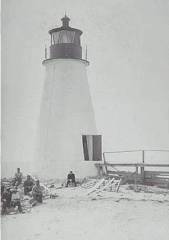 Coast Guard
Coast GuardBack River Light
Station
For
over 107 years, the Back River Light Station served as a beacon for mariners.
While the location is now a pile of rocks in the surf, its influence can
still be seen in the replicas which exist today. At a cost of under $5000, the light station was build in
1829. The lighthouse, which was
surrounded by dry land, was attached to the keeper's dwelling by a 144 feet
footbridge. Over the years, the
encroaching surf destroyed the base and eroded the land from around the station.
In addition to the surf, hurricanes (1903 and 1933) and the Civil War
helped to destroy the building. The
original structure was part of the problem -- it was built by the lowest bidder,
Winslow Lewis, who was a former ship's captain and not an engineer. Back River Light was poorly constructed (due to Lewis's
inexperience) which is part of the reason it is no longer standing today.
His main reason for bidding on the contract was to install the light,
which just happened to be his own invention.
It seemed to be his goal to install his Lewis lamps in as many
lighthouses as possible.
When
Congress instituted a Lighthouse Board to review all the lights on the
Chesapeake Bay in 1852, the inspector found bats in the hollow walls of the
light. Many repairs and
improvements were made to the light and its foundation over the years.
Finally in 1936, it was decommissioned.
However, just before it was
finally destroyed by Hurricane Flossie on September 27, 1956, it had been
purchased and the new owner planned to have it renovated.
In September 1931, it was the background for a possible murder. Jenny Graham Kane, wife of Professor Elisha Kent Kane III,
drown while trying to learn to swim near Grandview Beach not far from the
lighthouse. He was arrested and
tried for murder, but found not guilty. Some
accounts hint he is really guilty and others blame Jenny's family for trying to
ruin an innocent man.
 Coast Guard
Coast Guard

There are several replicas of the lighthouse in Fox Hill. The most famous one is located at 901 Beach Road and was built by Wallace Elliott in 1941. His wife, Virgie, wanted a gold fish pond. He gave her one -- adding the Keeper's dwelling and the lighthouse with a bridge linking the two over the pond. He chose to add the lighthouse and dwelling was in honor of the original where he spent many happy childhood days visiting his grandfather.

Mr.
Wallace Elliott's lighthouse and keeper's dwelling.